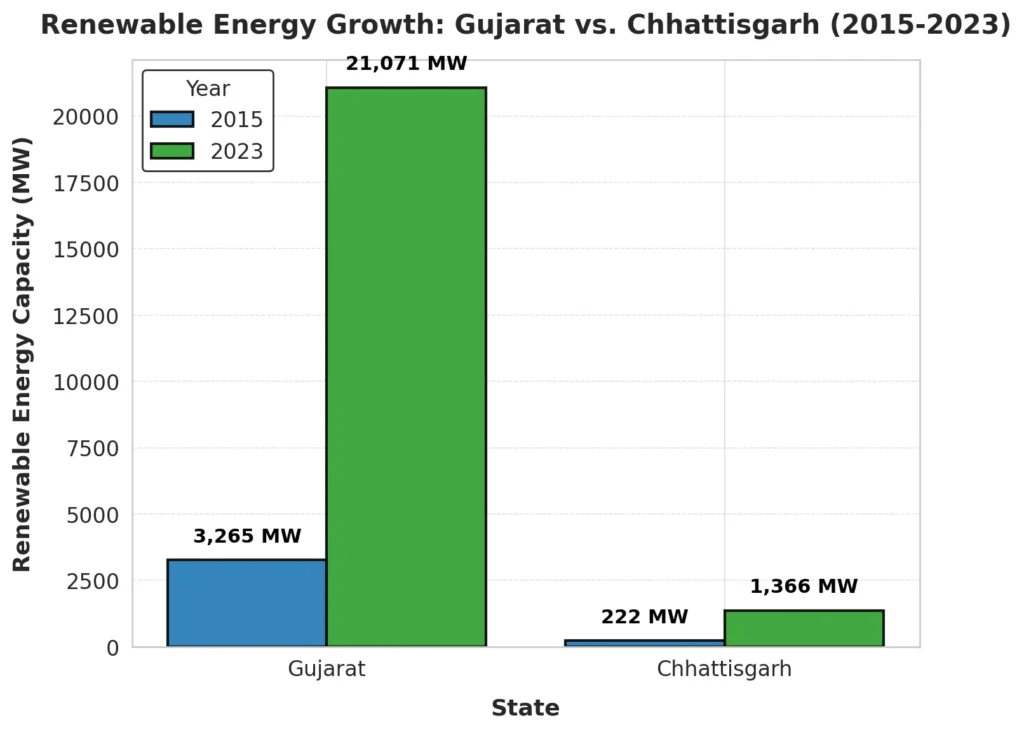Introduction
India has emerged as a global leader in renewable energy, with ambitious goals to expand its clean energy capacity. However, the effectiveness of renewable energy policies varies across states, influenced by factors like policy incentives, infrastructure, and governance. To quantify the impact of these policies, we apply a Difference-in-Difference (DiD) econometric analysis, comparing states with aggressive renewable energy policies to those with minimal interventions. This approach helps isolate the true effect of policy interventions on renewable energy capacity expansion, providing valuable insights into the role of policy design in driving sustainable energy transitions.
Methodology: The Difference-in-Difference Approach
The Difference-in-Difference (DiD) method is a widely used econometric technique that evaluates the impact of policy changes by comparing the before-and-after outcomes of a treatment group relative to a control group. This allows us to account for underlying trends and external factors that may influence renewable energy growth, ensuring that the observed differences are attributable to policy interventions rather than external economic or environmental changes.
For this analysis, we require state-wise data on renewable energy capacity, policy implementation records, and macroeconomic controls such as state GDP, industrial growth, and electricity demand. The data is sourced from publicly available government reports, including the Ministry of New and Renewable Energy (MNRE), as well as state energy reports and sectoral publications that provide detailed insights into policy measures and their implementation timelines.
Case Study: Gujarat vs. Chhattisgarh
To illustrate the application of DiD analysis, we examine the states of Gujarat and Chhattisgarh. Gujarat has been a frontrunner in renewable energy adoption, actively implementing supportive policies, while Chhattisgarh has lagged behind with relatively low renewable energy penetration. This contrast makes them ideal candidates for evaluating the impact of policy interventions.
In 2015, Gujarat had an installed renewable energy capacity of approximately 5,000 MW, which grew to 21,792.75 MW by 2023, reflecting the impact of various policy incentives, including subsidies, renewable purchase obligations, and ease of regulatory approvals for solar and wind projects. In contrast, Chhattisgarh had a renewable energy capacity of 1,000 MW in 2015, which increased marginally to 1,366.24 MW by 2023, indicating a slower adoption rate in the absence of proactive policy measures.

Source: Energy_Statistics_Report_2023
By applying the DiD formula:
$$ DiD = (Post – Pre)_{Treatment} – (Post – Pre)_{Control} $$
we estimate the additional renewable capacity induced by policy interventions. Substituting the values, we get:
$$ (21,070.95−3,265.46)−(1,366.24−222.35)=17,805.49−1,143.89=16,661.60 MW $$
This suggests that Gujarat’s renewable energy policies contributed an estimated additional 16,426.51 MW of renewable capacity compared to a state with minimal policy interventions. The significant difference underscores the effectiveness of targeted policy measures in accelerating renewable energy adoption.
Key Insights
The findings from this analysis highlight several crucial aspects of energy policy effectiveness in India. Firstly, proactive policy measures, such as financial incentives, regulatory streamlining, and infrastructure support, play a decisive role in driving renewable energy adoption. Gujarat’s success in expanding its renewable capacity demonstrates how well-designed policies can create a conducive environment for investment and innovation. Secondly, economic implications extend beyond energy generation, as increased renewable capacity contributes to job creation, industrial growth, and energy security by reducing dependency on fossil fuels. The comparative stagnation in Chhattisgarh underscores the need for more active policy engagement to unlock renewable energy potential in lagging states.
Furthermore, the acceleration of the energy transition depends on a strong and stable policy framework. The presence of clear, long-term policy commitments fosters investor confidence and encourages large-scale renewable energy projects. By contrast, states with inconsistent or weak policy support risk falling behind in the transition to clean energy, thereby missing out on both economic and environmental benefits.
Conclusion
The Difference-in-Difference analysis provides empirical evidence that proactive renewable energy policies lead to substantial capacity expansion. As India aims for a 500 GW renewable energy target by 2030, state-level policies will play a critical role in shaping the country’s energy future. Policymakers should leverage these insights to design targeted interventions that ensure a balanced and equitable transition across all states, addressing disparities in renewable energy adoption.
By using data-driven policy evaluation methods like DiD, we can make informed decisions that enhance India’s energy security while supporting sustainable economic growth. Continued research in this area will be essential for refining policy frameworks and ensuring that renewable energy expansion aligns with India’s broader development and climate goals.
If you found this analysis insightful, stay tuned for more data-driven policy evaluations and discussions on energy transitions in our upcoming blog posts.

